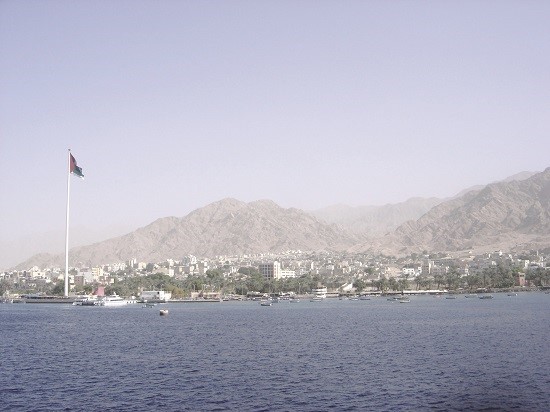AMMAN — US Ambassador to Jordan
Henry Wooster said
that the US will do everything to keep the stability of the
Hashemite Kingdom,
including helping the country deal with its endemic water crisis which he
described as “a building block for stability.” Speaking to representatives of
the local media on Sunday at his residence, Wooster said that the US takes the
water issue seriously not only because it is key to survival but because it is
fundamental to economic sustainability.
اضافة اعلان
 A general view of the sea in Aqaba. (Photo: Jordan News)
A general view of the sea in Aqaba. (Photo: Jordan News)
Wooster added that the challenge needs immediate action and
that the US supports the message repeated by the prime minister and the
minister of water over Jordan’s water challenge. “We share this concern and we
are here to help ... because it is a key interest of the US,” he said. He added
that in addition to potable and agriculture water needs, three largest
industries are being affected by water scarcity; tourism, textiles and mining,
saying that these sectors will be imperiled without water.
The US diplomat said that economic growth will be
constrained if Jordan does not diverse its water resources to ensure resilience
and stable supplies of water and that “Jordan should explore every available
option.”
Wooster added that the US supports
Jordan’s National Conveyance Project, which aims at desalinating sea water and pumping it to
Amman and other urban areas. He said that the project is functionally similar
in many ways to the now defunct Red-Dead project but the difference is that the
new project will be entirely sovereign.
He said that the US supports regional water development
projects and not only between Jordan and Israel, adding that these projects
should provide long-term solutions. Wooster said that regional integration is a
long-term foreign policy objective of the US.
On the recent
Declaration of Intent between Jordan, Israel
and the UAE, Wooster said that the US was not involved in negotiations and that
the deal is a commercial deal; between commercial entities and it is not a
sovereign project of any of the three countries, whose viability is to be
explored by the concerned parties.
He pointed to the need to adopt other reforms that include
water pricing, water conservation, water capturing and addressing non-revenue
water issues such as leaking pipes and thievery in addition to relying more on
renewable energy. Wooster said that no one of these is the solution but what is
needed is “a mixed menu.”
On her part, the director of
USAID and Jordan Mission, Sherry
Carlin, said that bridging the gap to keep up with growing [water] demand will
require more than $8billion of new infrastructure investments over the next
five to ten years. She said that Jordanians are facing a number of challenges
related to water scarcity including high price of tanked water, climate change
and over-pumping from already-depleted aquifers.
Carlin added that the US has committed over $500 million to
activities that support each and every one of these areas.
She revealed that USAID is building another pipeline
parallel to the existing pipeline linking Lake Tiberias in northern Israel to
Jordan in anticipation of high demand by Jordan to buy more water from Israel;
as was the case this year. The new pipeline should go online next year. Carlin
said that USAID is working with the Ministry of Water and Irrigation to support
the Aqaba-Amman Conveyance project, or the National Conveyance and has pledged
$100 million for it and is working with partners and donors to raise additional
funds.
She called for better water governance and financial
stability, adding that the water sector in the kingdom “runs at an extreme
financial deficit at around $500 million per year, or about 1 percent of the
GDP.” She added that for every JD1 paid by the consumer, the government spends
JD3 to extract, treat, pump and deliver water. Carlin said that the ongoing
deficit threatens the sector’s ability to pay for repairs and upgrades.
“We are working with the government to invest in grid
upgrades and energy reforms that facilitate renewable energy investments,” she
said. “If the government does not act now, it will lose an additional estimated
$600 million a year once the
Aqaba-Amman Conveyance comes online.”
Carlin said that USAID is also working with the government
to reduce water losses. “Nearly half of Jordan’s water is lost through leaks,
theft and inaccurate metering,” she said, with these losses amounting to $473
million in 2020. She added that the
government aims to reduce non-revenue water to 35 percent by 2040; leaving a
gap of about 420 million cubic meters per year; about half of overall water
needs.
She said that while more than 50 percent of Jordan’s water
is used for agriculture, the sector contributes only 4 percent to the GDP.
“USAID is encouraging the adoption of new technologies and better practices
and, to date, we have seen a total saving of 22.8 million cubic meters of water
over five years,” Carlin said. “Putting this in perspective, that is enough
water to supply the needs of 624,000 people for a year,” she concluded.
Read more National news



